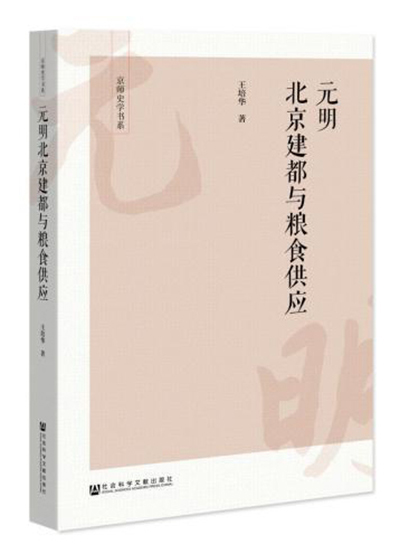
Yuan and Ming Capital Founding in Beijing and Grain Supply
Most researchers who specialize on Beijing’s history focus on its historical development process, yet few proceed beyond the interaction between natural conditions and historical development. Against this background, Yuan and Ming Capital Founding in Beijing and Grain Supply, authored by Wang Peihua, a professor from the School of History at Beijing Normal University, supplements the typical Beijing history research perspective. In particular, it centers on the key issue of grain supply for the capital Beijing during Yuan (1271–1368) and Ming (1368–1644) dynasties, which directly concerns the larger picture of imperial governance. Wang reviews ancient practices and understandings of capital cities from the Han (206 BCE–220) to Song (960–1279) eras, discussing macroscopic geographical locations and the microscopic natural geographical traits of Beijing and its neighboring regions.
The author explains the Yuan and Ming rulers’ and intellectuals’ thought process as they chose Beijing as the capital and how such understanding evolved. She continues to analyze natural geographical conditions of northern and southern China, as well as their impacts on agricultural production, grain supplies, and water transport specifically in terms of moving grain to the capital. Then, she elaborates on how Yuan and Ming courts worked to develop northern China (especially the capital’s surrounding areas, and farmland irrigation or water conservancy in northwestern China) and taxation policies in Jiangnan, the region south of the Yangtze River. Historical insights and warnings are revealed for later generations, such as the concepts of national food security and ecological environment construction in northwestern China.
The book is written from research of interactions between natural conditions and human social development, to study the Yuan and Ming era’s capital founding and grain supply. Untangling these historical interactions has always been a theoretical topic vigorously promoted and practiced by Bai Shouyi (1909–2000) and Qu Lindong, historians from Beijing Normal University. Wang further enriches historical theory through specific research.
Apart from historiography, historical geography (a branch of geography) also touches on relationships between geographic environments and human activities. The discipline emerged in the early 20th century, and took an embryonic form in the 1930s when the Yu Gong Society was founded. Historical geography was formally established in the early 1950s in China. The field traces back to China’s evolutionary geography, which studies changes in administrative divisions and place names and was once considered a sub-discipline of history or a subsidiary subject of geography. Over time, historical geography has gradually matured, revealing changes and laws of natural and human geographical environments that were affected by human activities in certain periods.
Zhu Shiguang is a professor from the Northwest Institute of Historical Environment and Socio-Economic Development at Shaanxi Normal University.
Edited by YANG LANLAN


 PRINT
PRINT CLOSE
CLOSE